
Send any comments to the maintainer Roger Caffin

Apparently poorly known to many, and certainly relatively unknown in NSW, is the 250 km long Great South West Walk between Portland and Nelson on the coast of Victoria near the SA border. It goes via forests and river bank from Portland to Nelson, and then back via beaches and headlands. It runs on well-marked tracks the whole way, some created just for this walk. There are dedicated walkers camp site with water and toilets at frequent intervals. The route is largely flat, but the country is very varied and interesting.
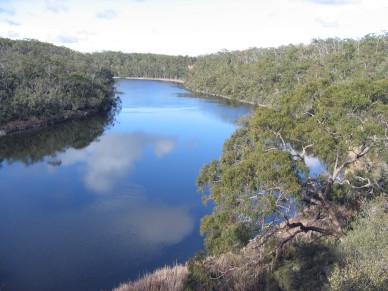
I gather this track was first mooted by some locals in the 1980s. An observer of the region might have laughed at the idea that one could create a decent walk in this area, but local persistence moved mountains and government departments, and the walk was created. It runs through some private property at the start, then State forests and National Parks. It runs along the huge Glenelg River for some distance. A topo map of the area will show it as flat, although there are little 10 - 20 m ups and downs in places.
Today (June 2005) it has a dedicated path, largely off all roads (except in some of the PP section), and there are specially cleared campsites for walkers. Each campsite has a toilet shed and an attached rainwater tank, which the 'Friends of the GSWW' (Gwen Bennet, 03 5523 5262) monitor and fill up as needed. It should be noted that these water tanks are very nearly the only sources of water available for the whole trip! The river looked murky and brackish when we were there. The campsites are quite close in places: some as close as 10 km apart, and there are 16 of them. There are also some 'tourist' campsites along the river section. The track has regular markers: red or orange arrows mainly on pine posts. Well, some of the paint has flaked off, leaving silver markers, but never mind. Some early markers remain on trees in a few places.
The Portland Visitor Information Centre or 'TIC' (03 5523 2671) has a large fold-out map ($2) of the walk and a small guide booklet ($3.95) which contains 8 strip maps. These can be either bought or cadged over the phone. I also downloaded free sections of topo maps from the Dept of Sustainability and Environment. However, while the topo maps did show some sections of the track, we found the guide book was quite sufficient for the walk - and the route was more accurate in places too. You could easily do the whole walk on the guidebook alone.
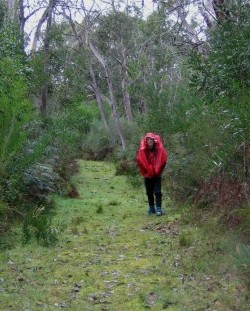
Early 2005 saw much of the east coast of Australia in a severe drought. Winter in Victoria is always a poor prospect, but we (my wife and I) thought it should at least be pretty dry and OK for a trip in June. The theory was fine, except that the drought broke a week before we started. As a result it did rain a bit on most days: not heavy rain, but it was cold rain, and sometimes on the coast section a bit windy as well. There was some resemblance to the winter weather of SW Tassie, with nights getting down to 0 C! There was also very high humidity and condensation on those nights.
There are 16 campsites on the books, plus another one or two new unlisted ones. However, many of these are close together, so we decided to do more than one section per day and, if necessary, carry water from the last tank and make our own campsites. In the event, we only camped outside the provided sites on two nights. We completed the 250 km in 8 nights and 9 days, but we clocking over 30 km on some days on the faster sections. The beaches were very nice but noticeably slow walking. For what it is worth, our stages were as follows, going anticlockwise from Portland:
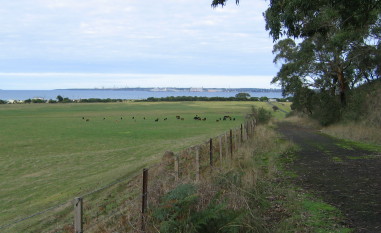
The 'normal' start for the walk is Portland. We drove there (Princes Hwy), but you can get there by bus and plane and train as well. There is plenty of information on the web about transport, and the people at the Portland TIC are very helpful. The TIC is on the waterfront.
The town is quite large and has lots of facilities: motels, shops, takeaways, etc. It also has a major port and a huge aluminium smelter just to the south, but the latter doesn't really intrude on the town. Pino's Pizzas was good, some of the Chinese cafes were not so good. The Bayview College on the waterfront has some rather curious statues at the front garden: very odd. We stayed the night in an inexpensive motel in Portland before we started walking. The motel owners knew about the GSWW, and offered to look after our car while we were walking: a good and safe idea for us, and of course for them it meant we would be likely to stay another night there on our return. We did, and used the hot shower in the motel room generously. Well, we needed it.
We had brought all our food with us, but could have bought a lot of it in Portland - except for the freeze-dry meals.
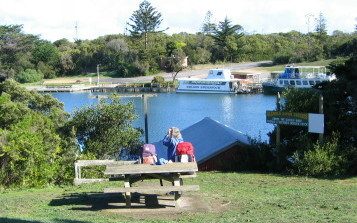
This town is at the half-way mark along the route, on the coast very near to the SA border, There is a good 'kiosk' there: more of a small country store really. They seemed to have a lot of food which might have been suitable if we had needed to buy more there. The Kiosk is apparently open 8 am to 6 pm 7 days a week. The Kiosk is also the local Post Office, and food parcels can be posted to it to be picked up. We did this from Portland, and having retrieved the parcel from the kiosk we repacked outside on a picnic bench.
What did surprise us was that most of the taps around Nelson were for non-potable water. Apparently the town runs on bore water, private rainwater tanks, and bottled water. Fortunately the Tourist Information Centre just nearby had a rainwater tank with a publically accessible tap. We filled a bottle there before moving on.
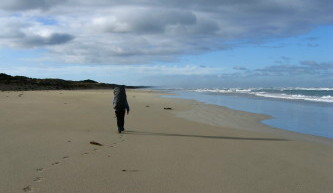
There are no serious difficulties on this route. You do have to keep an eye on your water supplies, and I would imagine that in mid-summer this could mean carrying a fair bit between tanks. In general, there is no water between camp sites. The forest walking is fast and easy on good wide tracks with quite adequate markings. The soil underfoot is usually fairly soft, except for the first stage through PP. Climbs of more than 20 (twenty!) metres are not common. The beach walking is a bit slower as the sand is sometimes soft: the trick here is to know just where to walk between the dunes and the water for the most solid surface. On the other hand, navigation is ... very easy. We did worry at the start about finding where we should leave the beach and move inland, but in general there were marker posts and large cuts through the dunes to flag these places. Near the end you wander around the back of the smelter and the streets of Portland, but even there the markers are sufficient.
Negatives were not many. There is a section through Private Property (PP) near the start. You have to walk roads to get out of Portland: that's obvious. The Loretto Forest bit is very pretty; the roads after that are a bit boring, but only last few a few hours. The section up the train line is rough in wet weather: some parts of the 4WD road there do get a bit muddy, and the railway ballast is bumpy. But it's only a few km. Vic Parks have decided to put thick layers of crushed blue metal on parts of the track around the headlands: a ridiculous decision outrageously incompatible with the environment and heads should roll for it. Sigh. There is an ashphalt walk around the back of the smelter coming back into Portland (Public Relations exercise by the smelter). I can't say we were very impressed, but it's short.
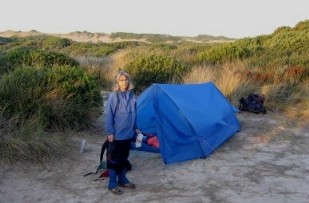
The track itself is usually very clear: they mow the forest bits regularly, but the scrub on either side of the track in many places is quite thick. Impenetrable would be a better description sometimes. We often found kangaroo tracks going for long distances along the track: there was nowhere for them to get off sideways. This does mean that it can be hard to accidentally stray off the track (how convenient!), but it also means that finding your own camp sites can be quite hard at times. That said, the tops of small rises in the forest sections were generally more open, and we found that we could usually find room for our tent given 15 - 30 minutes of walking. This is not a high density of camp sites! Given the shortage of water sources and the pleasant designated walker campsites, we were quite happy to use the latter in most cases.
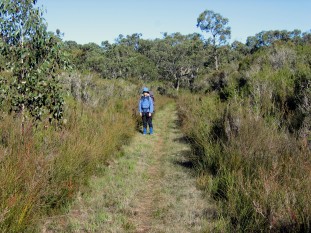
The designated camp sites are off the road, but usually do have 4WD access. The Friends of the GSWW use the access to maintain the sites and the tanks and the toilets. It did not seem that these tracks got a lot of use from other 4WD owners: maybe the distance from Melbourne helped. The sites are usually nicely mown and quite flat, with room for lots of tents scattered apart. There is usually a toilet, a tank, a typical park table with seats, and a steel BBQ fireplace. In some places where the ground was sloping they had carefully benched a number of generous tent sites. This was much more couth than the rough sloping sites we have often seen elsewhere. The toilets were mostly fairly new, with TP supplied.
As mentioned above, we used the rainwater from the tanks at the campsites. Basically, this was all that was available, apart from a couple of small creeks running into the Glenelg near Nelson. Well, there were some lakes behind the dunes, but we didn't check those as we weren't stopping at them and it was too cold for washing. Since the water in the tanks was obviously from the recent rains and the tanks were generally new, sealed polyethylene units, we departed from our usual practice and did not use a filter or any chemicals. We had no problems with the water. It was a bit tannin-coloured in places, but tasted OK.
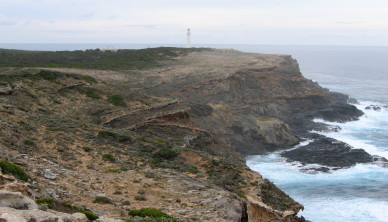
As mentioned above, the Portland TIC has a Guide Book called The Great South West Walk, and this is quite adequate. You leave Portland from the TIC, and there are markers right through the town. We had to guess our way past a new housing development, but this was pretty obvious since we knew we had to stick to the coast. The one error we found in the guidebook was right at the start, where they mention leaving the road at the Henty Bay Car Park: it's a caravan park. The new campsite on the Glenelg River near the SA border was not in the guide book - fair enough. I don't know what name they will give it, but 'Gizzy Camp' is carved into the top of the picnic table there.
The TIC also sent us a fold-out A3 tourist map of the walk, with accompanying walk notes. This was actually useful for preliminary planning and getting an overview of the whole walk. We took it with us, but it stayed folded up for most of the trip.
We also took some topo map sections, but quickly decided they were of little use. An interesting experience!
We took our normal ultralightweight summer walking gear. This was adequate - just. There was one night where the temperature was around 0 C and we wore all our thermals in our summer sleeping bags, and had our 200-fleece jackets on for the first 15 minutes of walking, but we were OK. With half the food on board, my pack weighed 14 kg and my wife's pack weighed 12 kg. Key items taken were as follows.
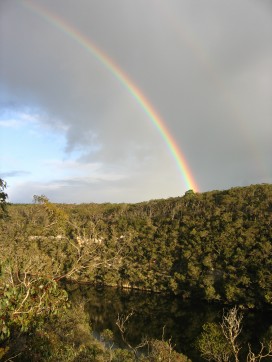
We took our normal bushwalking food. This ran at about 650 g/day for me and about 600 g/day for my wife. We could probably have restocked in Portland and Nelson if needed.
We took our own gas cartridges - Kovea 70% isobutane / 30% propane. I do not know if you can buy them at Portland; I doubt you could at Nelson. Our Snowpeak GST-100 functioned flawlessly, as usual, but any similar small gas stove would have done as well.
Apart from a bit of tiredness at the end of the longer days, we had no problems. We did not filter or treat the rainwater from the tanks. Most of the toilets were quite respectable. In any event, we were only a few km from the track to a road at almost any stage. From there I imagine you could hail a passing car. I do not know what the mobile phone coverage is like, but we don't carry one anyhow.
© Roger Caffin 18/7/2005